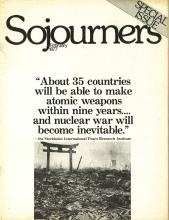Every president since Truman has said that there is no security in the arms race, but no president has acted as if he believed it. Today the United States has a stockpile of more than 9,000 weapons deliverable at intercontinental distances (with thousands more deliverable at forward bases surrounding the Soviet Union); the Soviet Union has about 3,500. Ten years ago Secretary of Defense MacNamara pointed out that 100 nuclear weapons landing on Soviet cities would destroy half their population and about two thirds of their industrial capacity.
Read the Full Article

Already a subscriber? Login
